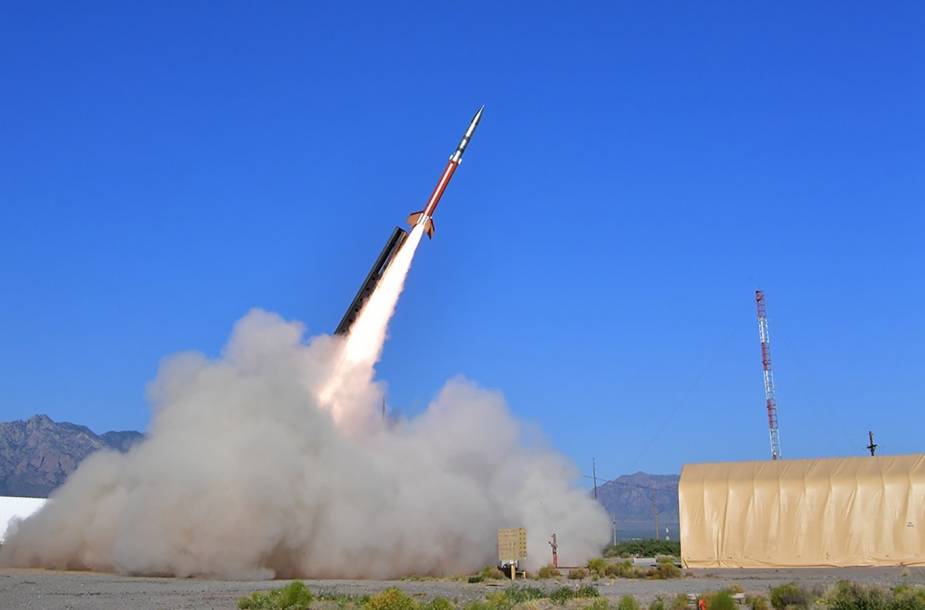Breaking news
US Army Space and Missile Defense Command Technical Center team launches economical target for missile tests.
A U.S. Army Space and Missile Defense Command Technical Center team once again provided a low-cost target for the future of the nation’s missile defense systems. An Economical Target-2, a missile target designed to fly a ballistic flight path and demonstrate defensive protection capability, launched from White Sands Missile Range, New Mexico, July 7, 2023. The flight served as a search track to test the Lower Tier Air and Missile Defense Sensor system. Jason Cutshaw, USASMDC, reports.
Follow Army Recognition on Google News at this link

The U.S. Army Space and Missile Defense Command Technical Center’s Targets Test Directorate launches an Economical Target-2, July 7, 2023, from White Sands Missile Range, New Mexico, during a flight test design serving as a search track to test the Lower Tier Air and Missile Defense Sensor system (Picture source: U.S. Army/Jason Cutshaw)
“It was great to see all the hard work put in by the team finally soar into the desert sky,” said Justin R. Novak, ET-2 assistant test director, Targets Test Directorate, Technical Center. “I learned that after all the planning, testing, checking and rechecking that until that rocket fires you won’t really know if it’s going to be a successful mission.”
During the mission, Novak was responsible for communicating with launch, range and missile defense system teams to ensure a healthy target is presented to the missile defense system being tested.
Like USASMDC’s Zombie missile targets, the ET-2s are repurposed demilitarized Army motors given life as targets. Although they do not have the accuracy of the guided Zombie targets, the command can provide this target at a fraction of the cost for situations where the target accuracy is a lower priority.
“The Economical Target uses excess and obsolete rocket hardware to keep cost at the bare minimum while delivering a target capable of testing our missile defense systems to ensure they are second to none for protecting our Soldiers and nation,” Novak said.
The ET-1 targets group started development in 2010 and flew a risk reduction flight in February 2012. The ET-2 program, developed as a follow-on from the ET-1 program, started development early in 2020 and is an upgraded version of the ET-1 target with a longer-range motor.
Novak said these targets help the Army with modernization by allowing for more frequent testing to occur within budget constraints. As new, improved missile defense technology is developed, flight tests are needed to demonstrate capabilities and increase efficiency of fielded technology.
“This mission tested sensors used to track air and missile defense threats in order to defeat and destroy them before they can harm ground forces and civilians,” Novak said. “Having the Economical Target in the Army’s target portfolio allows programs to conduct realistic testing while delivering cost-effective missile defense capabilities that are second to none.”
Jeff A. Compton, who served as launch director, said in his countdown role he observes the launch contractor during the count and provides any advice needed and relays information from the operations van to the test director if the team is assessing an off nominal condition. Additionally, Compton acts as access control to the launch pad to ensure the enforcement of the ground hazard area. During missile assembly and test, his role is quality and mission assurance.
“Every launch is exciting,” Compton said. “There’s just something about that final countdown, 3, 2, 1. Then seeing the fire and hearing the roar as the missile screams to life and flies downrange. My first launch was 27 years ago and I still get that same feeling every time. And throughout this launch, I had the need for systems engineering reinforced,” he added. “That’s my other job and I saw that need over and over. So I’m looking for ways to implement system engineering principles without breaking the target or driving the cost up.”
Compton said this was a tracking exercise for one of the Army’s new sensors and the customer used this flight to prove out tracking and discrimination algorithms and demonstrate hardware capabilities. He added the ET-2 targets are low cost, which means the team can provide more of them for the sensor to view and get more refinement.
Defense News July 2023



























